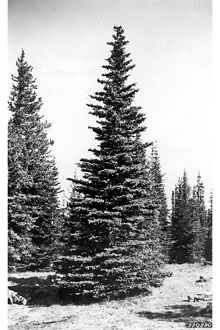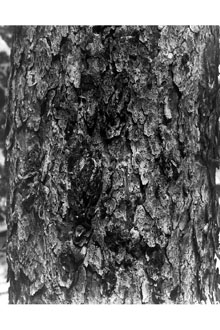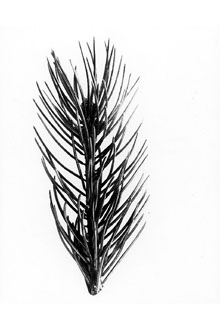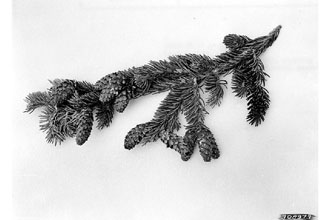Engelmann Spruce
Scientific Name: Picea engelmannii Parry ex Engelm.

| General Information | |
|---|---|
| Usda Symbol | PIEN |
| Group | Gymnosperm |
| Life Cycle | Perennial |
| Growth Habits | Tree |
| Native Locations | PIEN |
Plant Guide
Uses
The wood of Engelmann spruce is light-colored, relatively soft, low in resin, and sometimes contains many knots and is more valuable for pulp than for high-grade lumber. It has been used for home construction, pre-fabricated wood products, and plywood manufacture. Less commonly it is used for specialty items such as food containers, and sounding boards for violins, pianos, and guitars. Engelmann spruce is widely used for Christmas trees. Spruce beer was sometimes made from its needles and twigs and taken to prevent scurvy. The Engelmann spruce–subalpine fir forest association occupies the greatest water-yielding areas in the Rocky Mountains and the natural adaptations of these trees are important in maintaining stable vegetation.
Status
Please consult the PLANTS Web site and your State Department of Natural Resources for this plant’s current status, such as, state noxious status and wetland indicator values. Botany Dept., NMNH, Smithsonian Institution @ PLANTS
Description
General: Pine Family (Pinaceae). These are native trees growing to 60 meters tall, the crown dense and narrowly conic or spire-like. Branches spreading horizontally to somewhat drooping, the lower often persistent (not strongly self-pruning); twigs not pendent, rather stout, yellow-brown. Bark usually reddish- to purplish-brown and thin scaly. Needles are evergreen, borne singly from all sides of the twig, 1.6-3 (-3.5) cm long, 4-angled, stiff and sharp-pointed, blue-green. Seed cones are violet to deep purple, ripening buff-brown, ellipsoid, pendent, mostly 3-6 cm long, the cone scales relatively small, papery, and flexible, remaining intact after cones fall from the tree. Ssp. mexicana differs from the typical ssp. in its lighter (gray) bark, narrower needles (1-1.2 mm wide) and its narrower and slightly larger cones (4.5-8 cm long) and longer cone scales (4-6 mm), although the measurements are overlapping. Named for physician and botanist George Engelmann. Variation within the species: a primarily Mexican segment of Engelmann spruce is formally distinguished Picea engelmannii ssp. engelmannii Picea engelmannii ssp. mexicana (Martínez) P. Schmidt These populations also have been recognized as P. mexicana Martínez, P. engelmannii var. mexicana (Martínez) Taylor & Patterson (illegitimate name), and P. engelmannii var. mexicana (Martínez) Silba. Variation in seed dormancy and hardiness has been documented over the broad geographic range of the typical subspecies, but no other varieties are generally recognized. In the northern part of its range, Engelmann spruce hybridizes freely and intergrades with white spruce (P. glauca). In the Chilliwack River Valley of British Columbia, it apparently hybridizes with Sitka spruce (P. sitchensis).
Distribution
Alberta and British Columbia southward through Nevada, Utah, and Colorado, into Arizona and New Mexico; the southernmost populations in Arizona (Chiricahua Mountains) and New Mexico (Sierra Blanca) are ssp. mexicana, which otherwise extends southward into both the eastern and western sierras of northern Mexico. For current distribution, please consult the Plant Profile page for this species on the PLANTS Web site.
Establishment
Adaptation: In montane and subalpine forests, occurring as krummholz at timberline, sometimes growing down into the fir-aspen belt on moist, north facing slopes and in canyons; at 1000-3000 meters elevation. Engelmann spruce and subalpine firs form one of the most common forest associations in the Rocky Mountains. Planting: Open-grown trees of Engelmann spruce begin cone production at 15-40 years of age but the best seed production is between 150 and 250 years. Good seed crops are generally borne every 2-5 years Although Engelmann spruce will germinate in all light intensities found in nature, seedlings do not establish readily in the open – 40 to 60 percent of full shade is most favorable for seedling establishment at high elevations. Germination and establishment in undisturbed forest occur on duff, litter, partially decomposed humus, decaying wood, and mounds of mineral soil upturned by wind thrown trees. Because of its slow initial root penetration and extreme sensitivity to heat in the succulent stage, drought and heat girdling kill many first-year spruce seedlings. Drought losses can continue to be significant throughout the Rocky Mountains during the first 5 years of seedling development, especially during prolonged summer dry periods. Once established (at least 5 years old), the ability to survive is favored by adequate soil moisture, cool temperature, and shade. The strong shade tolerance of Engelmann spruce allows it to occur both as a persistent long-lived seral species and as a major climax species. Engelmann spruce will grow steadily for 300 years, long after the growth of most associated tree species slows down. Dominant spruces are often 250-450 years old and trees 500-600 years old are not uncommon. Trees reaching 760-850 years are known.
Management
The shallow root system of Engelmann spruce makes it susceptible to windthrow, particularly after cutting opens a stand. Downed wood from windthrow also makes a site vulnerable to attack from the spruce beetle, which has periodically caused severe damage. The western spruce budworm is another potentially damaging insect that attacks both Engelmann spruce and subalpine fir. Complete removal of a spruce-fir stand by fire or logging results in such drastic environmental changes that spruce and fir are usually replaced by lodgepole pine, aspen, or shrub and grass communities. The kind of vegetation initially occupying the site usually determines the length of time it takes to return to a spruce-fir forest. It may vary from a few years, if the site is initially occupied by lodgepole pine or aspen, to as many as 300 years, if grass is the replacement community. Cultivars, Improved and Selected Materials (and area of origin) These plant materials are readily available from commercial sources. Contact your local Natural Resources Conservation Service (formerly Soil Conservation Service) office for more information. Look in the phone book under ”United States Government.” The Natural Resources
Conservation
Service will be listed under the subheading “Department of Agriculture.”
References
Alexander, R,R, & W,D, Shepperd 1990, Picea engelmannii, Pp, 187-203, IN R,M, Burns and B,H, Honkala, Silvics of North America, Volume 1, Conifers, USDA Forest Service Agric, Handbook 654, Washington, D,C, <http://willow,ncfes,umn,edu/silvics_manual/Table_of_contents,htm> LaRoi, G,H, & J,R, Dugle 1968, A systematic and genecological study of Picea glauca and P, engelmannii, using paper chromatography of needle extracts, Canadian J, Bot, 46:649-687, Taylor, R,J, 1993, Picea, Pp, 369-373, IN: Flora of North America, north of Mexico, Vol, 2, Pteridophytes and gymnosperms, Oxford Univ, Press, New York, <http://hua,huh,harvard,edu/cgi-bin/Flora/flora,pl?FLORA_ID=12395> Taylor, R,J, & T,F, Use soil moisture sensors to measure the soil moisture of Engelmann Spruce., Patterson 1980, Biosystematics of Mexican spruce species and populations, Taxon 29:421-469, Taylor, R,J,, T,F, Patterson, & R,J, Harrod 1994, Systematics of Mexican spruce – revisited, Syst, Bot, 19:47-59,
Plant Traits
Growth Requirements
| Temperature, Minimum (°F) | -50 |
|---|---|
| Adapted to Coarse Textured Soils | No |
| Adapted to Fine Textured Soils | Yes |
| Adapted to Medium Textured Soils | Yes |
| Anaerobic Tolerance | None |
| CaCO3 Tolerance | High |
| Cold Stratification Required | No |
| Drought Tolerance | Low |
| Fertility Requirement | Low |
| Fire Tolerance | Low |
| Frost Free Days, Minimum | 30 |
| Hedge Tolerance | Low |
| Moisture Use | Medium |
| pH, Maximum | 8.0 |
| pH, Minimum | 6.0 |
| Planting Density per Acre, Maxim | 700 |
| Planting Density per Acre, Minim | 300 |
| Precipitation, Maximum | 160 |
| Precipitation, Minimum | 21 |
| Root Depth, Minimum (inches) | 20 |
| Salinity Tolerance | None |
| Shade Tolerance | Tolerant |
Morphology/Physiology
| Bloat | None |
|---|---|
| Toxicity | None |
| Resprout Ability | No |
| Shape and Orientation | Conical |
| Active Growth Period | Spring and Summer |
| C:N Ratio | High |
| Coppice Potential | No |
| Fall Conspicuous | No |
| Fire Resistant | No |
| Flower Color | Yellow |
| Flower Conspicuous | No |
| Foliage Color | Green |
| Foliage Porosity Summer | Dense |
| Foliage Porosity Winter | Dense |
| Foliage Texture | Medium |
| Fruit/Seed Conspicuous | No |
| Nitrogen Fixation | None |
| Low Growing Grass | No |
| Lifespan | Long |
| Leaf Retention | Yes |
| Known Allelopath | No |
| Height, Mature (feet) | 120.0 |
| Height at 20 Years, Maximum (fee | 30 |
| Growth Rate | Slow |
| Growth Form | Single Stem |
| Fruit/Seed Color | Brown |
Reproduction
| Vegetative Spread Rate | None |
|---|---|
| Small Grain | No |
| Seedling Vigor | Low |
| Seed Spread Rate | Slow |
| Seed per Pound | 135040 |
| Fruit/Seed Persistence | No |
| Propagated by Tubers | No |
| Propagated by Sprigs | No |
| Propagated by Sod | No |
| Propagated by Seed | Yes |
| Propagated by Corm | No |
| Propagated by Cuttings | No |
| Bloom Period | Late Spring |
| Commercial Availability | Routinely Available |
| Fruit/Seed Abundance | Medium |
| Fruit/Seed Period Begin | Summer |
| Fruit/Seed Period End | Fall |
| Propagated by Bare Root | Yes |
| Propagated by Bulb | No |
| Propagated by Container | Yes |
Suitability/Use
| Veneer Product | Yes |
|---|---|
| Pulpwood Product | Yes |
| Protein Potential | Low |
| Post Product | Yes |
| Palatable Human | No |
| Palatable Graze Animal | Low |
| Palatable Browse Animal | Medium |
| Nursery Stock Product | Yes |
| Naval Store Product | Yes |
| Lumber Product | Yes |
| Fuelwood Product | Medium |
| Fodder Product | No |
| Christmas Tree Product | No |
| Berry/Nut/Seed Product | No |



